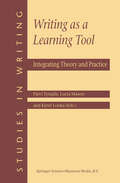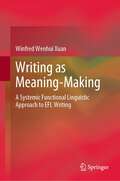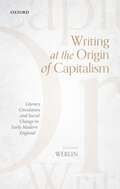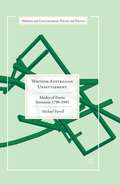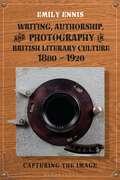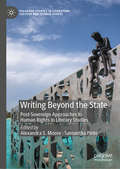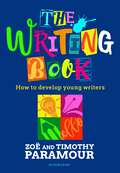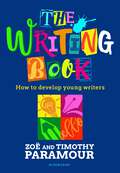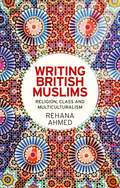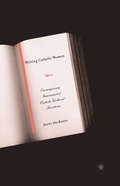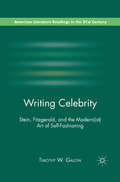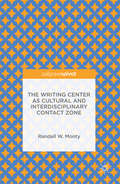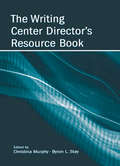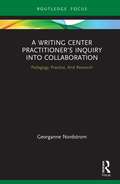- Table View
- List View
Writing as a Learning Tool: Integrating Theory and Practice (Studies in Writing #7)
by KirstiLonka LuciaMason PäiviTynjäläThis book is an outstanding account of the current state of using writing in service of learning. It presents psychological and educational foundations of writing across the curriculum movement and describes writing-to-learn practices implemented at different levels of education. It provides concrete applications and ideas about how to enhance student learning by means of writing. It is useful for educators, curriculum developers, psychologists, cognitive scientists, writing researchers, and teachers.
Writing as Meaning-Making: A Systemic Functional Linguistic Approach to EFL Writing
by Winfred Wenhui XuanThis book investigates Chinese secondary EFL learners’ meaning-making abilities in English L2 writing by adopting theoretical frameworks used in systemic functional linguistics (SFL). It offers a comprehensive guide to Chinese high school students’ use of lexico-grammatical resources in L2 English writing for frontline L2 writing teachers, TESOL practitioners, pre-service teachers, and all professionals engaged in researching and teaching L2 writing. In particular, the book seeks to fill the current gaps in secondary school L2 writing research in the Asian context.
Writing at the Origin of Capitalism: Literary Circulation and Social Change in Early Modern England
by Julianne WerlinIn the late sixteenth through seventeenth centuries, England simultaneously developed a national market and a national literary culture. Writing at the Origin of Capitalism describes how economic change in early modern England created new patterns of textual production and circulation with lasting consequences for English literature. Synthesizing research in book and media history, including investigations of manuscript and print, with Marxist historical theory, this volume demonstrates that England's transition to capitalism had a decisive impact on techniques of writing, rates of literacy, and modes of reception, and, in turn, on the form and style of texts. Individual chapters discuss the impact of market integration on linguistic standardization and the rise of a uniform English prose; the growth of a popular literary market alongside a national market in cheap commodities; and the decline of literary patronage with the monarchy's loosening grip on trade regulation, among other subjects. Peddlers' routes and price integration, monopoly licenses and bills of exchange, all prove vital for understanding early modern English writing. Each chapter reveals how books and documents were embedded in wider economic processes, and as a result, how the origin of capitalism constituted a revolutionary event in the history of English literature.
Writing at the Origin of Capitalism: Literary Circulation and Social Change in Early Modern England
by Julianne WerlinIn the late sixteenth through seventeenth centuries, England simultaneously developed a national market and a national literary culture. Writing at the Origin of Capitalism describes how economic change in early modern England created new patterns of textual production and circulation with lasting consequences for English literature. Synthesizing research in book and media history, including investigations of manuscript and print, with Marxist historical theory, this volume demonstrates that England's transition to capitalism had a decisive impact on techniques of writing, rates of literacy, and modes of reception, and, in turn, on the form and style of texts. Individual chapters discuss the impact of market integration on linguistic standardization and the rise of a uniform English prose; the growth of a popular literary market alongside a national market in cheap commodities; and the decline of literary patronage with the monarchy's loosening grip on trade regulation, among other subjects. Peddlers' routes and price integration, monopoly licenses and bills of exchange, all prove vital for understanding early modern English writing. Each chapter reveals how books and documents were embedded in wider economic processes, and as a result, how the origin of capitalism constituted a revolutionary event in the history of English literature.
Writing at the State U: Instruction and Administration at 106 Comprehensive Universities
by Emily IsaacsWriting at the State U presents a comprehensive, empirical examination of writing programs at 106 universities. Rather than using open survey calls and self-reporting, Emily Isaacs uses statistical analysis to show the extent to which established principles of writing instruction and administration have been implemented at state comprehensive universities, the ways in which writing at those institutions has differed from writing at other institutions over time, and how state institutions have responded to major scholarly debates concerning first-year composition and writing program administration. Isaacs’s findings are surprising: state university writing programs give lip service to important principles of writing research, but many still emphasize grammar instruction and a skills-based approach, classes continue to be outsized, faculty development is optional, and orientation toward basic writing is generally remedial. As such, she considers where a closer match between writing research and writing instruction might help to expose and remedy these difficulties and identifies strategies and areas where faculty or writing program administrators are empowered to enact change. Unique in its wide scope and methodology, Writing at the State U sheds much-needed light on the true state of the writing discipline at state universities and demonstrates the advantages of more frequent and rigorous quantitative studies of the field.
Writing Australian Unsettlement: Modes of Poetic Invention 1796-1945 (Modern and Contemporary Poetry and Poetics)
by Michael FarrellA bold work of synthetic scholarship, Writing Australian Unsettlement argues that the history of Australian literature contains the rough beginnings of a new literacy. Michael Farrell reads songs, letters and visual poems by Indigenous farmers and stockmen, the unpunctuated journals of early settler women, drover tree-messages and carved clubs, and a meta-commentary on settlement from Moore River (the place escaped from in The Rabbit-Proof Fence) in order to rethink old forms. The book borrows the figure of the assemblage to suggest the active and revisable nature of Australian writing, arguing against the "settling" effects of its prior editors, anthologists, and historians. Avoiding the advancement of a new canon, Farrell offers instead an unsettled space in which to rethink Australian writing.
Writing, Authorship and Photography in British Literary Culture, 1880 - 1920: Capturing the Image
by Emily EnnisAt the turn of the 20th century, printing and photographic technologies evolved rapidly, leading to the birth of mass media and the rise of the amateur photographer. Demonstrating how this development happened symbiotically with great changes in the shape of British literature, Writing, Authorship and Photography in British Literary Culture, 1880-1920 explores this co-evolution, showing that as both writing and photography became tools of mass dissemination, literary writers were forced to re-evaluate their professional and personal identities. Focusing on four key authors-Thomas Hardy, Bram Stoker, Joseph Conrad and Virginia Woolf-each of which had their own private and professional connections to photographs, this book offers valuable historical contexts for contemporary cultural developments and anxieties. At first establishing the authors' response to developing technologies through their non-fiction, personal correspondences and working drafts, Ennis moves on to examine how their perceptions of photography extend into their major works of fiction: A Laodicean, Dracula, The Secret Agent, The Inheritors and The Voyage Out. Reflecting on the first 'graphic revolution' in a world where text and image are now reproduced digitally and circulated en masse and online, Ennis redirects our attention to when image and text appeared alongside each other for the first time and the crises this sparked for authors: how they would respond to increasingly photographic depictions of everyday life, and in turn, how their writing adapted to a distinctly visual mass media.
Writing, Authorship and Photography in British Literary Culture, 1880 - 1920: Capturing the Image
by Emily EnnisAt the turn of the 20th century, printing and photographic technologies evolved rapidly, leading to the birth of mass media and the rise of the amateur photographer. Demonstrating how this development happened symbiotically with great changes in the shape of British literature, Writing, Authorship and Photography in British Literary Culture, 1880-1920 explores this co-evolution, showing that as both writing and photography became tools of mass dissemination, literary writers were forced to re-evaluate their professional and personal identities. Focusing on four key authors-Thomas Hardy, Bram Stoker, Joseph Conrad and Virginia Woolf-each of which had their own private and professional connections to photographs, this book offers valuable historical contexts for contemporary cultural developments and anxieties. At first establishing the authors' response to developing technologies through their non-fiction, personal correspondences and working drafts, Ennis moves on to examine how their perceptions of photography extend into their major works of fiction: A Laodicean, Dracula, The Secret Agent, The Inheritors and The Voyage Out. Reflecting on the first 'graphic revolution' in a world where text and image are now reproduced digitally and circulated en masse and online, Ennis redirects our attention to when image and text appeared alongside each other for the first time and the crises this sparked for authors: how they would respond to increasingly photographic depictions of everyday life, and in turn, how their writing adapted to a distinctly visual mass media.
Writing Back: American Expatriates' Narratives of Return (Rethinking Theory)
by Susan WinnettThe migration of American artists and intellectuals to Europe in the early twentieth century has been amply documented and studied, but few scholars have examined the aftermath of their return home. Writing Back focuses on the memoirs of modernist writers and intellectuals who struggled with their return to America after years of living abroad.Susan Winnett establishes repatriation as related to but significantly different from travel and exile. She engages in close readings of several writers-in-exile, including Henry James, Harold Stearns, Malcolm Cowley, and Gertrude Stein.Writing Back examines how repatriation unsettles the self-construction of the "returning absentee" by challenging the fictions of national and cultural identity with which the writer has experimented during the time abroad. As both Americans and expatriates, these writers gained a unique perspective on American culture, particularly in terms of gender roles, national identity, artistic self-conception, mobility, and global culture.
Writing Back: American Expatriates' Narratives of Return (Rethinking Theory)
by Susan WinnettThe migration of American artists and intellectuals to Europe in the early twentieth century has been amply documented and studied, but few scholars have examined the aftermath of their return home. Writing Back focuses on the memoirs of modernist writers and intellectuals who struggled with their return to America after years of living abroad.Susan Winnett establishes repatriation as related to but significantly different from travel and exile. She engages in close readings of several writers-in-exile, including Henry James, Harold Stearns, Malcolm Cowley, and Gertrude Stein.Writing Back examines how repatriation unsettles the self-construction of the "returning absentee" by challenging the fictions of national and cultural identity with which the writer has experimented during the time abroad. As both Americans and expatriates, these writers gained a unique perspective on American culture, particularly in terms of gender roles, national identity, artistic self-conception, mobility, and global culture.
Writing Beirut: Mappings of the City in the Modern Arabic Novel (Edinburgh Studies in Modern Arabic Literature)
by Samira AghacyExploring the ways in which writers utilize the spaces of the city †“ joining the factual with the imaginary †“ this book shows how idiosyncratic perceptions of Beirut are produced, generating an infinite number of Beiruts. The city emerges as interactive, dynamic and historical, a place that is created from the streets, buildings, and monuments as well as through performance and social interaction. By referring to factual places in Beirut, the novels produce a strong reality effect through a mimetic mode of expression. Simultaneously, these texts reveal that Beirut is an unstable locale that resists fixity and transparency, shifting between the real and imagined, and the quotidian and discursive. Writing Beirut explores the city in 16 Arabic novels focusing on the urban/rural divide, the imagined and idealized city, the city through panoramic views and pedestrian acts, the city as sexualized and gendered, and the city as a palimpsest. While the book focuses on Beirut in Arabic novels, the introduction provides a thorough overview of Beirut in the modern Arabic novel.
Writing Beyond the State: Post-Sovereign Approaches to Human Rights in Literary Studies (Palgrave Studies in Literature, Culture and Human Rights)
by Alexandra S. Moore Samantha PintoThis book investigates the imaginative capacities of literature, art and culture as sites for reimagining human rights, addressing deep historical and structural forms of belonging and unbelonging; the rise of xenophobia, neoliberal governance, and securitization that result in the purposeful precaritization of marginalized populations; ecological damage that threatens us all, yet the burdens of which are distributed unequally; and the possibility of decolonial and posthuman approaches to rights discourses. The book starts from the premise that there are deep-seated limits to the political possibilities of state and individual sovereignty in terms of protecting human rights around the world. The essays explore how different forms, materials, perspectives, and aesthetics can help reveal the limits of normative human rights and contribute to the cultural production of new human rights imaginaries beyond the borders of state and self.
The Writing Book: How to develop young writers
by Zoë Paramour Timothy ParamourEverything you need to teach writing in the primary classroom.The Writing Book helps you to break down the mysteries of written English into comprehensible steps that will get your students writing with confidence and flair.Written in Zoë and Timothy Paramour's funny, frank and reassuring style, this follow up to The Grammar Book gives teachers clear and systematic guidance about how to develop children's written English. It covers vocabulary, register, word order and text layout, as well as sentence structure, length and syntax. It explores the features of different genres, the ways we can play with language and the reader's expectations to make writing more engaging.The Writing Book gives teachers a clear and consistent language they can use with their students to offer meaningful feedback, especially when children's writing lacks flair and energy. Written by teachers for teachers, it provides tips, tricks, and adaptable resources to make teachers' lives easier. This book makes it easy for teachers to identify everything their students need to know to become confident, competent writers.
The Writing Book: How to develop young writers
by Zoë Paramour Timothy ParamourEverything you need to teach writing in the primary classroom.The Writing Book helps you to break down the mysteries of written English into comprehensible steps that will get your students writing with confidence and flair.Written in Zoë and Timothy Paramour's funny, frank and reassuring style, this follow up to The Grammar Book gives teachers clear and systematic guidance about how to develop children's written English. It covers vocabulary, register, word order and text layout, as well as sentence structure, length and syntax. It explores the features of different genres, the ways we can play with language and the reader's expectations to make writing more engaging.The Writing Book gives teachers a clear and consistent language they can use with their students to offer meaningful feedback, especially when children's writing lacks flair and energy. Written by teachers for teachers, it provides tips, tricks, and adaptable resources to make teachers' lives easier. This book makes it easy for teachers to identify everything their students need to know to become confident, competent writers.
Writing British Muslims: Religion, class and multiculturalism
by Rehana AhmedThe Rushdie affair, September 11 2001 and 7/7 pushed British Muslims into the forefront of increasingly fraught debate about multiculturalism. Stereotyping images have proliferated, reducing a heterogeneous minority group to a series of media soundbites.This book examines contemporary literary representations of Muslims by British writers of South Asian Muslim descent – including Salman Rushdie, Hanif Kureishi, Monica Ali and Nadeem Aslam – to explore the contribution they make to urgent questions about multicultural politics and the place of Muslims within Britain. By focusing on class, and its intersection with faith, ‘race’ and gender in identity- and community-formation, it challenges the dichotomy of secular freedom versus religious oppression that constrains thinking about British Muslims, and offers a more nuanced perspective on multicultural debates and controversies.Writing British Muslims will appeal to academics and postgraduate and final-year undergraduate students in the fields of postcolonial studies, English studies and cultural studies.
Writing Business: Genres, Media and Discourses (Language In Social Life)
by Catherine Ross Nickerson Francesca Bargiela-ChiappiniWriting Business: Genres, Media and Discourses offers an analysis of the genres and functions of written discourse in the business context, involving a variety of modes of communication. The evolution of new forms of writing is a key focus of this collection and is only partly attributable to the ever increasing application of technology at work. Alongside machine-mediated texts such as electronic mail and computer-generated correspondence, the contextualised analyses of both traditional genres such as facsimiles and direct mailing, and of lesser studied texts such as invitations for bids, contracts, business magazines and ceremonial speeches, reveal a rich complexity in the forms of communication evolved by organisations and the individuals who work within them, in response to the demands of the social, organisational and cultural contexts in which they operate. This rich textual variation is matched by a discussion of a range of methodological approaches to the development of business writing skills, including rhetorical analysis, organisational communication analysis, social constructionism, genre analysis and survey and experimental methods. Using authentic data and benefiting from a fresh, interdisciplinary approach, the volume will be of interest to students and researchers of business communication, Language for Specific Purposes (LSP), English for Specific Purposes (ESP), and sociolinguistics.
Writing Business: Genres, Media and Discourses (Language In Social Life)
by Catherine Ross Nickerson Francesca Bargiela-ChiappiniWriting Business: Genres, Media and Discourses offers an analysis of the genres and functions of written discourse in the business context, involving a variety of modes of communication. The evolution of new forms of writing is a key focus of this collection and is only partly attributable to the ever increasing application of technology at work. Alongside machine-mediated texts such as electronic mail and computer-generated correspondence, the contextualised analyses of both traditional genres such as facsimiles and direct mailing, and of lesser studied texts such as invitations for bids, contracts, business magazines and ceremonial speeches, reveal a rich complexity in the forms of communication evolved by organisations and the individuals who work within them, in response to the demands of the social, organisational and cultural contexts in which they operate. This rich textual variation is matched by a discussion of a range of methodological approaches to the development of business writing skills, including rhetorical analysis, organisational communication analysis, social constructionism, genre analysis and survey and experimental methods. Using authentic data and benefiting from a fresh, interdisciplinary approach, the volume will be of interest to students and researchers of business communication, Language for Specific Purposes (LSP), English for Specific Purposes (ESP), and sociolinguistics.
Writing Catholic Women: Contemporary International Catholic Girlhood Narratives
by J. DelRossoWriting Catholic Women examines the interplay of gender, race, ethnicity, nationality, and sexuality through the lens of Catholicism in a wide range of works by women writers, forging interdisciplinary connections among women's studies, religion, and late twentieth-century literature. Discussing a diverse group of authors, Jeana DelRosso posits that the girlhood narratives of such writers constitute highly charged sites of their differing gestures toward Catholicism and argues that an understanding of the ways in which women write about religion from different cultural and racial contexts offers a crucial contribution to current discussions in gender, ethnic, and cultural studies.
Writing Celebrity: Stein, Fitzgerald, and the Modern(ist) Art of Self-Fashioning (American Literature Readings in the 21st Century)
by T. GalowWriting Celebrity is divided into three major sections. The first part traces the rise of a national celebrity culture in the United States and examines the impact that this culture had on "literary" writing in the decades before World War II. The second two sections of the book demonstrate the relevance of celebrity for literary scholarship by re-evaluating the careers of two major American authors, F. Scott Fitzgerald and Gertrude Stein.
The Writing Center as Cultural and Interdisciplinary Contact Zone
by Randall W. MontyWriting centers are complex. They are places of scholarly work, spaces of interdisciplinary interaction, and programs of service, among other things. With this complexity in mind, this book theorizes writing center studies as a function of its own rhetorical and discursive practices. In other words, the things we do and make define who we are and what we value. Through a comprehensive methodological framework grounded in critical discourse analysis, this book takes a closer look at prominent writing center discourses by temporarily shifting attention away from the stakeholders, work, locations, and scholarship of the discipline, and onto things—the artifacts and networks that make up the discipline. Through this approach, we can see the ways the discipline reinforces, challenges, reproduces, and subverts structures of institutional power. As a result, writing center studies can be seen a vast ecosystem of interconnectivity and intertextuality.
The Writing Center Director's Resource Book
by Christina Murphy Byron L. StayThe Writing Center Director's Resource Book has been developed to serve as a guide to writing center professionals in carrying out their various roles, duties, and responsibilities. It is a resource for those whose jobs not only encompass a wide range of tasks but also require a broad knowledge of multiple issues.The volume provides information on the most significant areas of writing center work that writing center professionals--both new and seasoned--are likely to encounter. It is structured for use in diverse institutional settings, providing both current knowledge as well as case studies of specific settings that represent the types of challenges and possible outcomes writing center professionals may experience. This blend of theory with actual practice provides a multi-dimensional view of writing center work.In the end, this book serves not only as a resource but also as a guide to future directions for the writing center, which will continue to evolve in response to a myriad of new challenges that will lie ahead.
The Writing Center Director's Resource Book
by Christina Murphy Byron L. StayThe Writing Center Director's Resource Book has been developed to serve as a guide to writing center professionals in carrying out their various roles, duties, and responsibilities. It is a resource for those whose jobs not only encompass a wide range of tasks but also require a broad knowledge of multiple issues.The volume provides information on the most significant areas of writing center work that writing center professionals--both new and seasoned--are likely to encounter. It is structured for use in diverse institutional settings, providing both current knowledge as well as case studies of specific settings that represent the types of challenges and possible outcomes writing center professionals may experience. This blend of theory with actual practice provides a multi-dimensional view of writing center work.In the end, this book serves not only as a resource but also as a guide to future directions for the writing center, which will continue to evolve in response to a myriad of new challenges that will lie ahead.
A Writing Center Practitioner's Inquiry into Collaboration: Pedagogy, Practice, And Research (Routledge Research in Writing Studies)
by Georganne NordstromThis book presents a model of Practitioner Inquiry (PI) as a systematic form of empirical research and provides a rationale for its suitability within a writing center context. Exploring the potential of writing centers as pedagogical sites that support research, the book offers an accessible model that guides both research and practice for writing center practitioners, while offering flexibility to account for their distinct contexts of practice. Responding to the increasing call in the field to produce empirical “RAD” (replicable, aggregable, data-driven) research, the author explores Practitioner Inquiry through explication of methodology and methods, a revisitation of collaboration to guide both practice and research, and examples of application of the model. Nordstrom grounds this research and scholarship in Hawaiʻi’s context and explores Indigenous concepts and approaches to inform an ethical collaborative practice. Offering significant contributions to empirical research in the fields of writing center studies, composition, and education, this book will be of great relevance to writing center practitioners, anyone conducting empirical research, and researchers working in tutor professionalization, collaboration, translingual literacy practices, and researchmethodologies.
A Writing Center Practitioner's Inquiry into Collaboration: Pedagogy, Practice, And Research (Routledge Research in Writing Studies)
by Georganne NordstromThis book presents a model of Practitioner Inquiry (PI) as a systematic form of empirical research and provides a rationale for its suitability within a writing center context. Exploring the potential of writing centers as pedagogical sites that support research, the book offers an accessible model that guides both research and practice for writing center practitioners, while offering flexibility to account for their distinct contexts of practice. Responding to the increasing call in the field to produce empirical “RAD” (replicable, aggregable, data-driven) research, the author explores Practitioner Inquiry through explication of methodology and methods, a revisitation of collaboration to guide both practice and research, and examples of application of the model. Nordstrom grounds this research and scholarship in Hawaiʻi’s context and explores Indigenous concepts and approaches to inform an ethical collaborative practice. Offering significant contributions to empirical research in the fields of writing center studies, composition, and education, this book will be of great relevance to writing center practitioners, anyone conducting empirical research, and researchers working in tutor professionalization, collaboration, translingual literacy practices, and researchmethodologies.
Writing Center Research: Extending the Conversation
by Paula Gillespie Alice Gillam Lady Falls Brown Byron StayThere are writing centers at almost every college and university in the United States, and there is an emerging body of professional discourse, research, and writing about them. The goal of this book is to open, formalize, and further the dialogue about research in and about writing centers. The original essays in this volume, all written by writing center researchers, directly address current concerns in several ways: they encourage studies, data collection, and publication by offering detailed, reflective accounts of research; they encourage a diversity of approaches by demonstrating a range of methodologies (e.g., ethnography, longitudinal case study; rhetorical analysis, teacher research) available to both veteran and novice writing center professionals; they advance an ongoing conversation about writing center research by explicitly addressing epistemological and ethical issues. The book aims to encourage and guide other researchers, while at the same time offering new knowledge that has resulted from the studies it analyzes.
